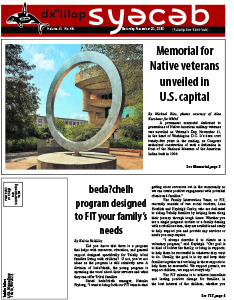Please use the following link to download the December 5, 2020 issue of the syəcəb
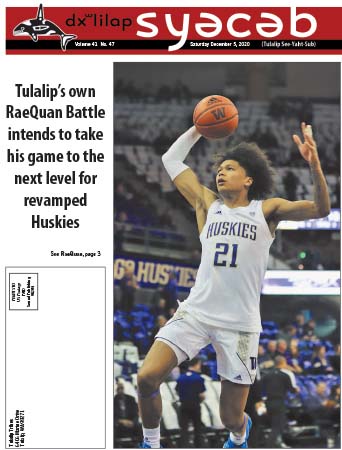
syəcəb
Please use the following link to download the December 5, 2020 issue of the syəcəb

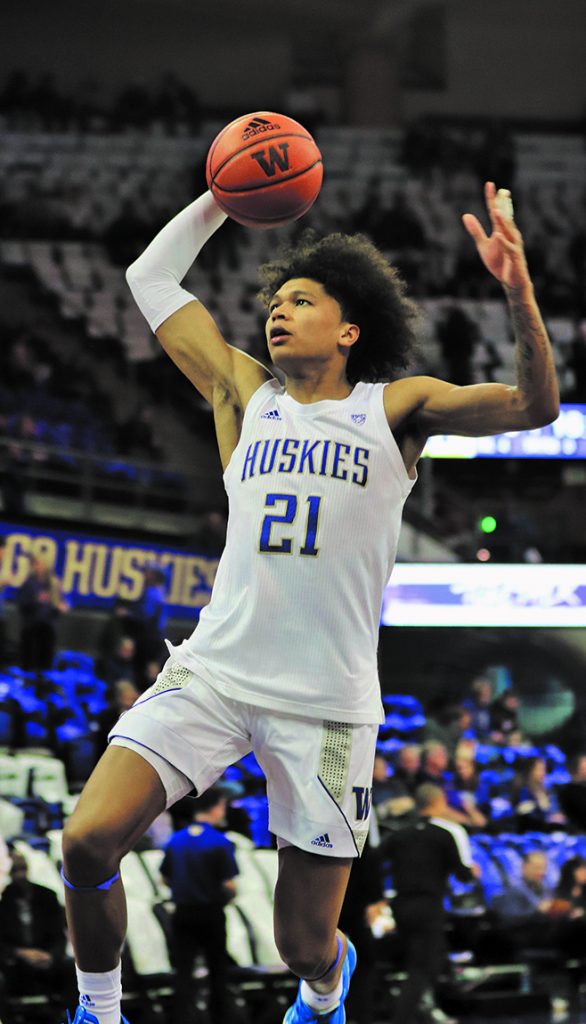
By Micheal Rios, Tulalip News
Tulalip tribal member RaeQuan Battle has been getting buckets since the moment he was able to shoot a basketball. From his early days spent endlessly shooting in the Tulalip Boys & Girls Club gymnasium to his more formative years at Marysville Pilchuck High School, where he led the Tomahawks to back-to-back State tournaments, RaeQuan’s talents on the hardwood have always been astonishing.
Last year, during his freshman season at the prestigious University of Washington, RaeQuan showed his shooting touch was made for the collegiate level. Averaging a shade over 11 minutes per game, he scored double-digit points five times, connected on twenty-two 3-pointers, and saw action in twenty games for the Huskies.
Now in his second year, the Tulalip phenom is determined to take his game to an even higher level. A sentiment echoed by his head coach during the offseason.
“The thing that makes him great is, he’s got what great players have, which is ultimate confidence,” Huskies head coach Mike Hopkins told The News Tribune. “I believe that he thinks if he took a half-court shot, it’s going in…I wish I had that as a player.
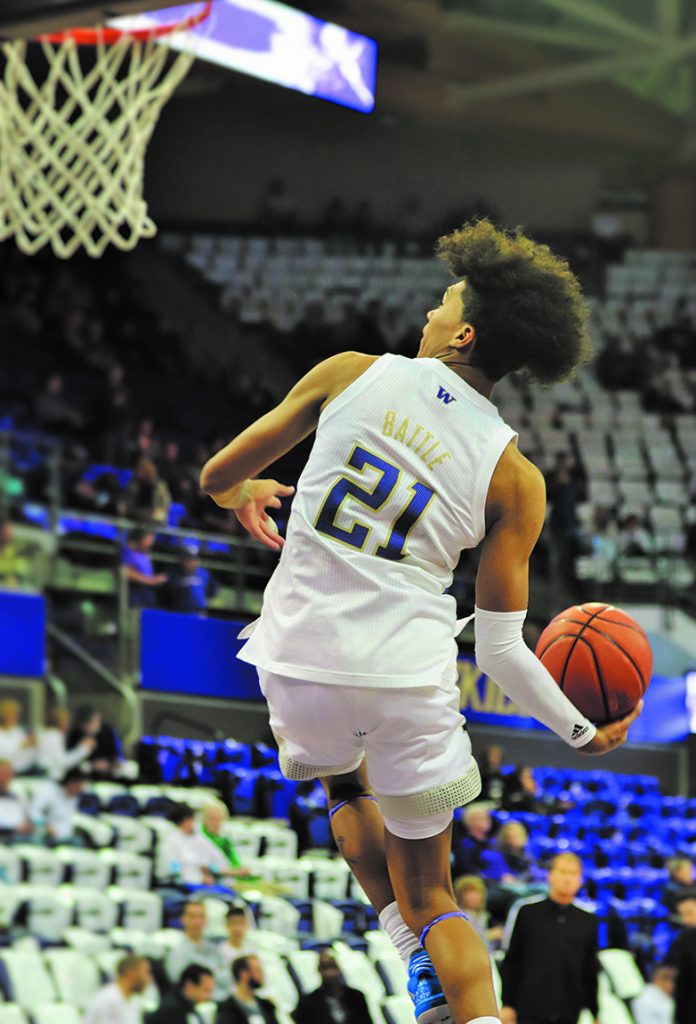
“At the end of the day, he had some incredible moments as a freshman,” Hopkins continued. “His ability to shoot the ball and he’s got a quick release. The one thing that people don’t know about RaeQuan, [he] can fly. Like he can really jump. His future is on a different level. His potential is just limitless.”
Limitless potential. That’s very high praise from any coach, especially one running a D-1 collegiate program. To his credit, the 19-year-old RaeQuan fully understands that in order to reach his full potential he has to continue training his body for the strength and conditioning necessary to compete on both sides of the court, while continuing to look for ways to improve his all-around game.
“I’m focused on improving my ball handling and my defense. Once I’ve added those to my game, to go with my shooting and athletic abilities, I could do whatever I want on the basketball court,” said the sophomore sharpshooter. “Hitting the gym for a variety of workouts to help me get stronger is a priority, too. I know putting in the work will make me better.”
All his dedication to improving his game in the offseason was on full display in the Huskies season opener versus the #2 ranked team in the country, Baylor, on November 29. Coming off the bench, the 6’5 shooting guard led his team in scoring and minutes played. Never one to shy away from an open 3-pointer, he went 2-8 from downtown while also displaying his court vision for three assists.
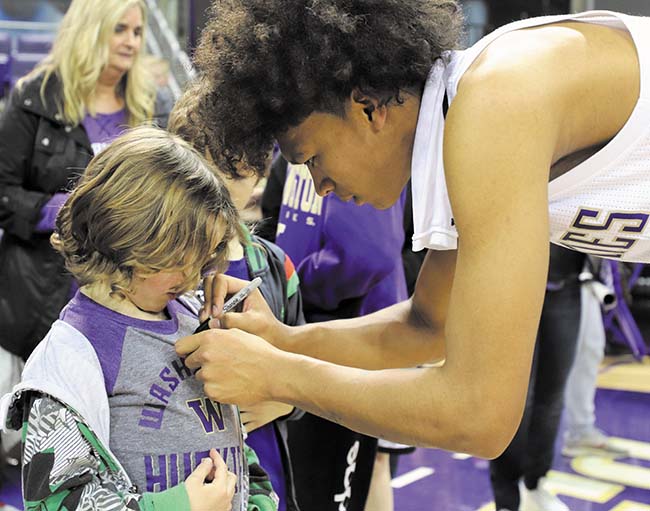
Outside of his athletic prowess on the court, RaeQuan has accepted the mantle as cultural ambassador for his Native culture. Something many his age typically shy away from.
“I do consider myself an ambassador for the Tulalip Reservation,” he explained. Even on the Seattle campus with thousands of students, he stands out for his towering frame and eagerly describes his proud Tulalip culture to anyone curious enough to ask. “Whenever my name gets said, I want people to think of Tulalip, and for everyone back home to know I’m proud of where we come from.”
Quite literally wearing his culture on his sleeves, RaeQuan has a number of tattoos honoring his tribe. ‘Respect the past, Create the future’, accented by eagle feathers, is on the inside of his left arm. However, it’s the large Lushootseed print on both forearms that stand out most. One arm reads ‘dxʷlilap’ (Lushootseed spelling of Tulalip) and the other ‘səswix̌ab’ (Lushootseed spelling of his mom, Jacquie Battle’s Indian name).
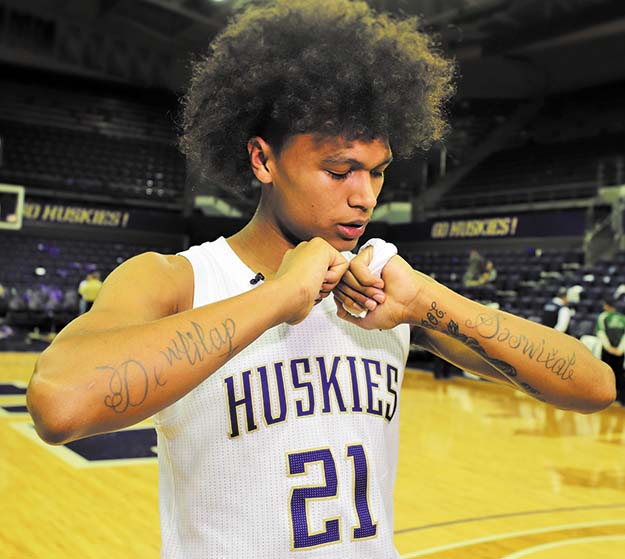
“I wear number 21 for my mom,” said the Marysville Pilchuck alum. “She wore it in high school. My mom worked her butt off to provide for me and my siblings. She’s always done whatever is necessary for us, and I want to repay her by being the best man that I can be.”
With his playing time expected to increase this season and his offensive role sure to expand as well, the future remains bright for Tulalip’s latest sports icon. With the ultimate hoops dream to play in the NBA, RaeQuan remains dedicated to all the youth who adore him as their hero.
“It means a lot knowing [Tulalip youth] look up to me because I’m proud to be a role model to them and show them what’s possible,” he shared. “I still love visiting the Boys & Girls Club and the Teen Center on the reservation because it brings back a lot of memories, and it shows all the kids that I haven’t forgot about them. After all, they are my number one fans.”
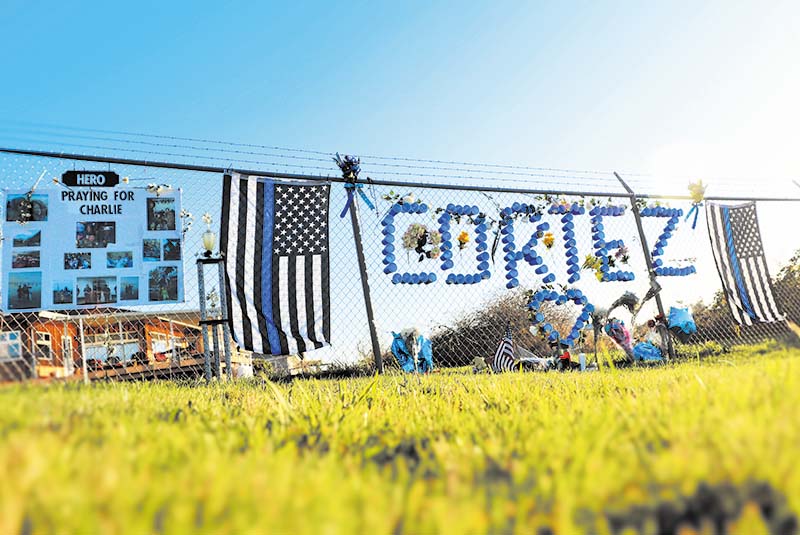
By Micheal Rios & Niki Cleary
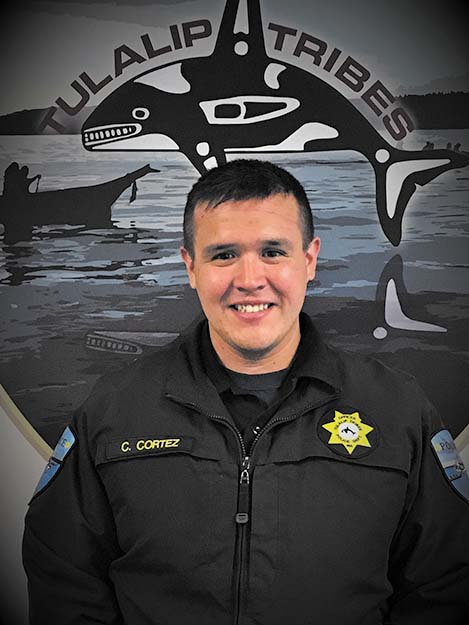
The Tulalip Marina is home to an ever-growing memorial dedicated to the memory of Fish and Wildlife Officer Charlie Cortez. Overlooking the bay and a fleet of fishing boats, community members have contributed a number of heartfelt items to the memorial.
From the blue plastic cups that spell out ‘CORTEZ’ in the chain link fence to the two thin blue line flags gently flowing in the breeze to all blue balloons and flower bouquets, the sentiment of Blue Lives Matter, a movement representing police solidarity and recognition for all law enforcement who’ve paid the ultimate sacrifice, is visually captivating on such revered ground.
The marina tribute was established soon after the community was notified Tulalip had suffered its first ever death by an officer in the line of duty.
On evening of November 17, two officers with Tulalip Police Department’s Fish and Wildlife division were following another boat into the Everett Marina to ensure the fishermen reached port. Officers Shawn Edge and Charlie Cortez were returning to Tulalip Bay when a rogue wave hit their 24ft patrol vessel, causing it to capsize. Both men were thrown into the water.
Officer Edge, boat operator and captain, was located and rescued near Hat Island by Tulalip fishermen. He was immediately transported to the hospital and is currently recovering. Officer Cortez is still missing and presumed deceased.
“As our search and rescue effort transitioned to a search and recovery, we are heartbroken. Our people are connected to the water and we know what we risk when we go out. We lost a good man, a father, brother and son,” said Chairwoman Teri Gobin. “Our hands go up to the many fisherman and rescue workers who continue to answer the call to find our missing officer. In the face of tragedy, our community came together and we will continue to come together as we take care of his family.”
A coordinated search and recovery effort continues today with multiple agencies, in addition to numerous tribal fishing vessels from Tulalip and neighboring tribes.
“Charlie was a wonder man and officer. We are devastated by this loss,” said Chief Sutter. “Tulalip Fish and Wildlife are often called upon to conduct searches such as this one. I know Charlie would have been there for you, and I can’t say thank you enough to the many individuals and agencies that came together to be there for him. The search for our missing officer will continue until he is brought home.”
The Tulalip community can’t express enough our gratitude for all those who have chosen to continue assisting in the search, both on land and sea. Our search continues.
If you choose to search, please help us by continuing to check in and share the details of your search. Tulalip fishermen, please continue to text 360-926-5059, or check in with Tulalip Fisheries or Robert Myers. Other volunteers, please describe your search details by emailing bringofficercortezhome@gmail.com or leaving a voice mail at (909) 294-6356.
If you find the following clothing similar to the following, please call in an eye-witness report to the non-emergency line (425) 407-3999.
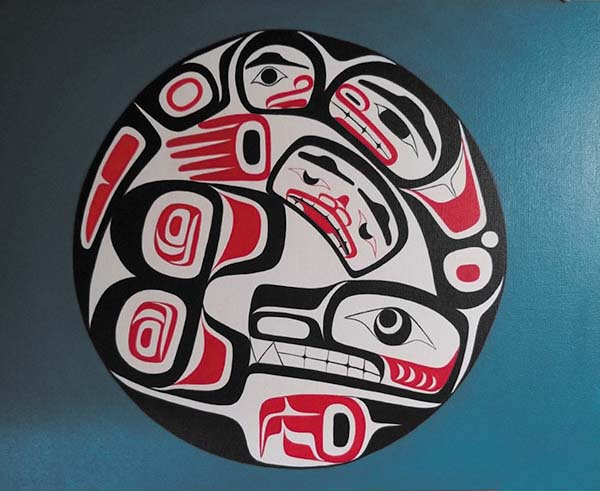
Are you looking for interesting, artistic, and one-of-a-kind gifts this season? Meet artist Michael Hoover.
Bibliographic Information
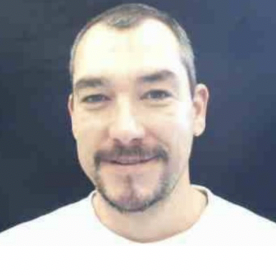
Born in north Seattle’s Waldo Hospital at Northgate on February 6, 1973 I have been a lifelong resident of Washington state. I grew up in the township of Woodway, a small suburban community within the city of Edmonds.
I had the privilege of growing up in a household that practiced old fashioned family values. We prayed together, went to church on Sundays and were taught the values of hard work and honesty.
Life, however, was not always so Rockwellian. I spent many years enduring hardships, isolation, and a sort of self-imposed exile. I went down a hard road and developed a substance use disorder which led me to make some very poor and very regrettable decisions which in turn took me down a path of incarceration. In 2006 I was convicted of robbery and sent to prison for the rest of my life, and without the possibility of parole. As bleak as my prospects were, I was determined to make the best of the situation I had made for myself.
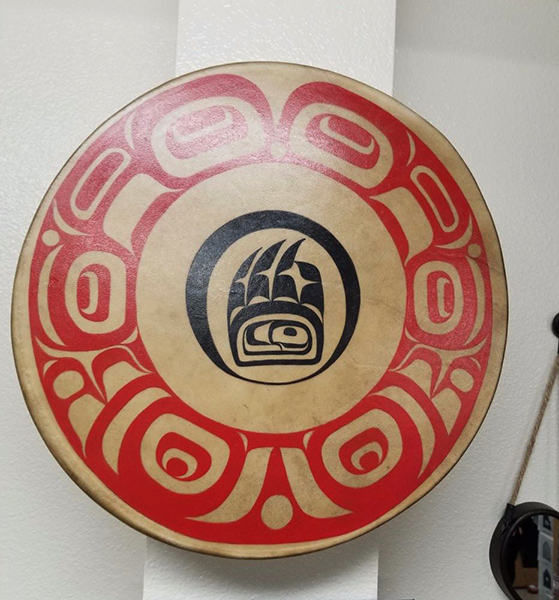
Although I had been sent to prison my father had become a staunch supporter and good friend. And so it was that I strived to live a life that would make my father proud. After several years and some adjustments in my thinking I was bestowed the great honor of serving as the Native American Pipe Man at the Washington State Penitentiary. I remained in that position from 2009 to 2018. I made many personal connections with individuals throughout this time. Within these connections I was reunited with humanity and the sense of dignity that comes with serving others. It was during this time that I grew as a person, and as an artist. I fell in love with the mate of my soul and I was given the opportunity to live life without the burden of addiction and the shame that comes with it.
In 2017 Governor Jay Inslee commuted my life without parole sentence to a determinate 231 months. I now have a release date of February 2, 2025. Since being given this rare and extraordinary act of grace I have enrolled in Walla Walla Community College and am working to earn my Associates Degree in Social work. Upon my eventual release I wish to continue working with at risk individuals who have found themselves in the unlikely place that is prison or those who are facing the trauma of their past who are at risk of incarceration. It will be my duty as a citizen to never again commit a crime and to honor those whom I have harmed in my past by being a beacon of change and a force for good.
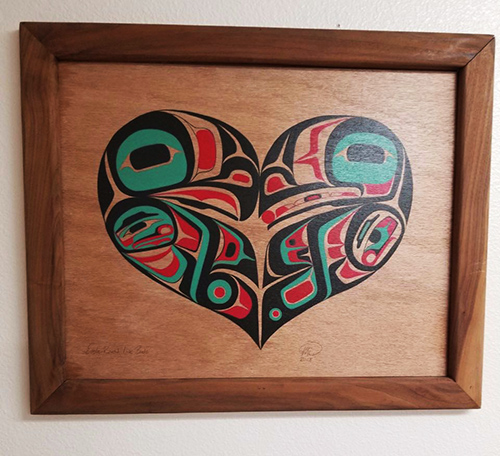
I don’t know exactly how the future will play out but my faith in God and with the support of my family and beautiful wife I know I will be exactly where I am supposed to be. And, that whatever station I find myself in, I will continue to make my father proud.
Artist Statement
As a man of Lumbee Irish American ancestry, I was raised with Native and urban American influences. My works of art are inspired by the Powerful and ancient Northwest Coast Indian Art form and are a reflection of my cross-cultural experiences. Most works are executed in acrylic paint and often incorporate reclaimed wood as my medium. Mixed-media paintings incorporate items from the natural world such as abalone shell and unprocessed wood. A few of my older pieces from years ago are not original. I was learning the art form by replicating the beautiful art of others. To them I am grateful and do my best to refer to another artist’s work if I know the source.
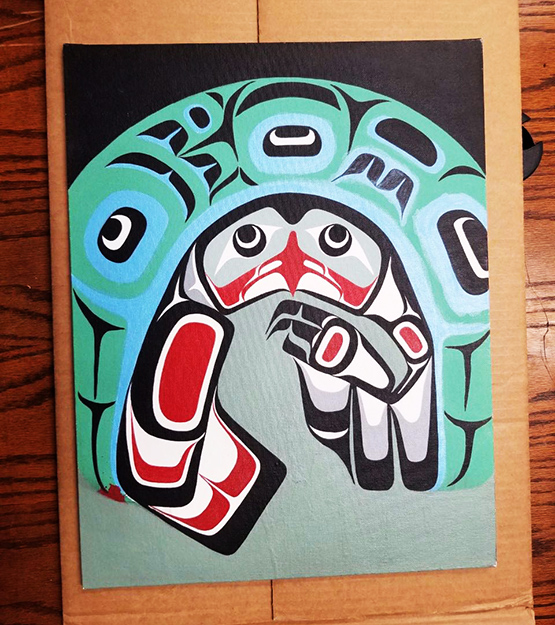
I strive to create evocative pieces that pay respect to the history of the Salish people and the Native culture. Many of my pieces reflect cultural and religious function such as dancing, drumming, and praying which are a celebration and acknowledgement of all parts of my history. This art form allows me to express my world view: joy, sadness, freedom, incarceration and my ever deepening cultural awareness. I am honored to be practicing such a revenant and spiritual art form that spans generations and inspires transformation both internally and externally. This platform allows me to start from center, deepening my own understanding of all the complexities of culture and storytelling through the construction of ancient elements.
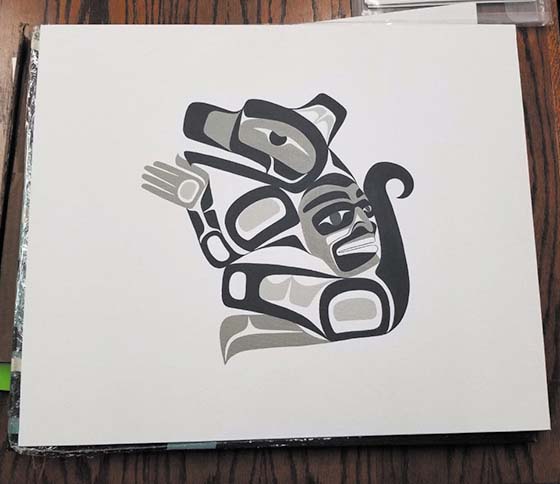
By highlighting the strength, beauty, power, gracefulness and legacy of Northwest Coast Indian Art I hope to inspire a recognition of indigenous art as a bridge between the past, present and future. The audience is invited to consider that the history of the past is truly intertwined with the present. I believe the past echoes in each of our hearts and that art strikes a vibrant chord in the soul which reminds us that parallel histories are truly intertwined.
It is my hope that my art will inspire a conversation about the challenges of indigenous artist who attempt to create art which is both evocative and meaningful from such an oppressive environment such as prison and the lack of representation of underprivileged artist in the mainstream.
Please Visit my Facebook page at Northwest Coastal Art by Michael Hoover, or my web site at northwestcoastalpainting.com
To purchase artwork, contact Stephanie Beidman by email at newbeginningslewistonidah@gmail.com, cell phone 509-254-3151 or phone 208-746-7661.
————————————————————————
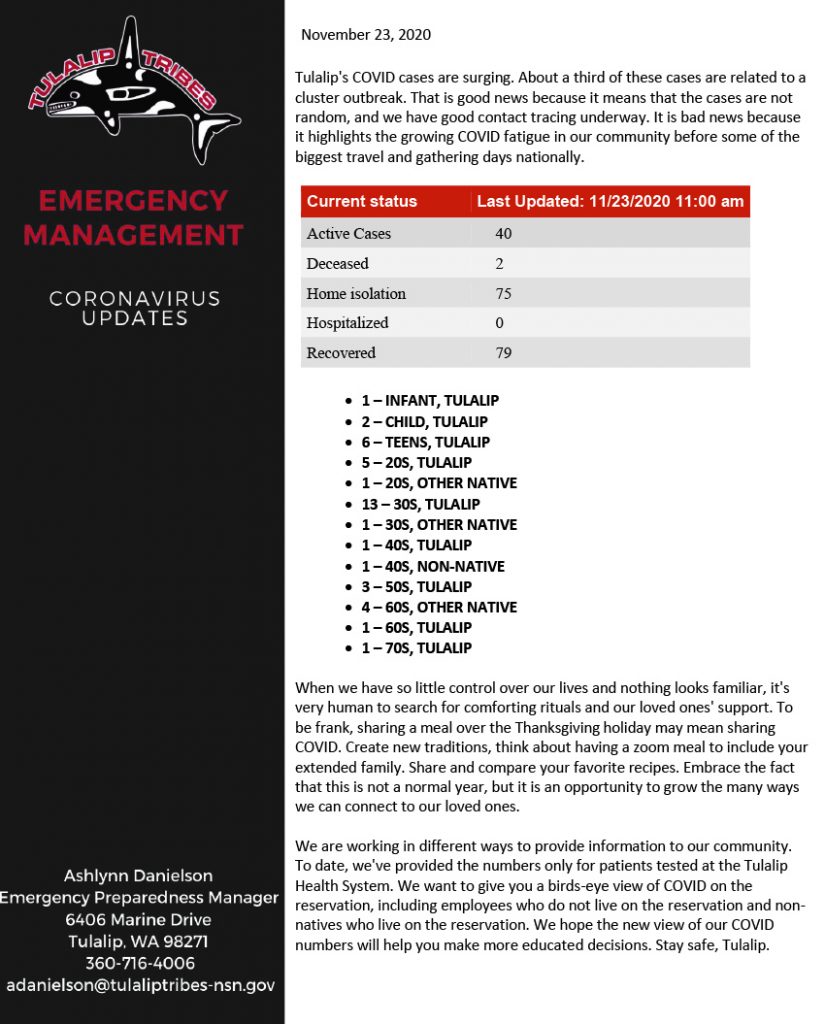
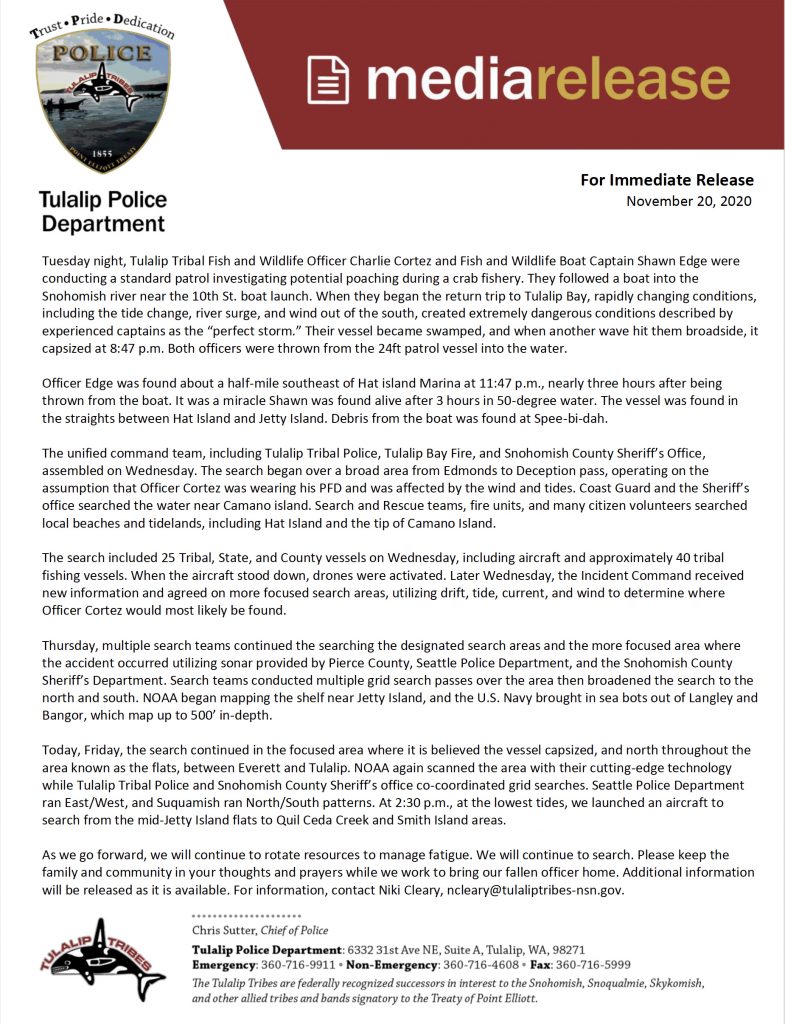
October 15, 1950 – November 13, 2020
Robert (Bob) Lee Power at the age of 70 passed away peacefully at Providence Hospital in Everett, WA 11/13/2020, with loved ones by his side.
Bob is survived by his mother; Dorothy (Hawkins) Power; brother Paul Power; children: Ivy Guss, Selena Guss, Robert Guss, and Anthony Power. Also many grandchildren, great-grandchildren, nieces, nephews, and numerous other family and close friends.
Bob was preceded in death by his father; Paul Power; brother Bill Power; sons Albert Power, and John Gibson.
Bob was loved and adored by so many and will be greatly missed. He was a kind hearted man, who loved his family and friends beyond words, he showed us in so many ways.
He was somebody who was always willing to help where needed. A man of many talents, from being an amazing mechanic, who also had an extreme love for old muscle cars, to building wood furniture back in his school age years which his mother still has the honor of using in her home today.
Bob was the best father, son, grandpa, brother, uncle, and friend anybody could ask for.
A graveside service will be held Saturday, November 21, 2020 at 10:00 AM at Mission Beach Cemetery in Tulalip. Arrangements entrusted to Schaefer-Shipman Funeral Home.
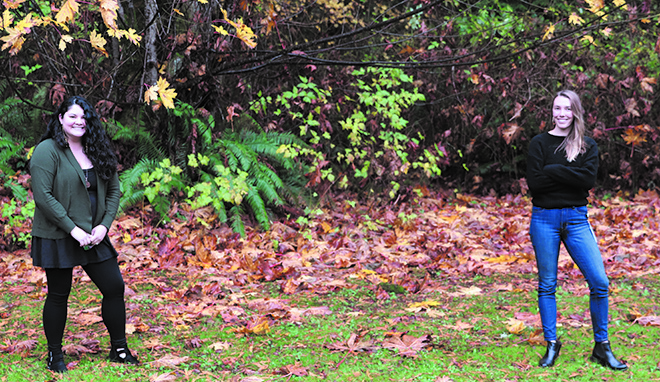
By Kalvin Valdillez, Tulalip News
Did you know that there is a program that helps with resources, education, and general support designed specifically for Tulalip tribal families living with children? If not, you’re not alone as the program is still relatively new. A division of beda?chelh, the young program is spreading the word about their services and what they can offer Tribal families.
Stated beda?chelh manager, Natasha Fryberg, “I want to bring forth our FIT team to start getting more resources out in the community so we can create positive engagement with potential clients and families.”
The Family Intervention Team, or FIT, currently consists of two social workers, Lena Hoeflich and Kayleigh Canby, who are dedicated to aiding Tulalip families by helping them along their journey through tough times. Whether you are a single pregnant mother or a family dealing with a rebellious teen, they are available and ready to help support you and provide any services or needs you may require.
“I always describe it to clients as a voluntary program,” said Kayleigh. “Our goal is to kind of bolster the family, or bring in supports, to help them be successful in whatever they want to do. Usually, the goal is to try and keep their families together and we bring in those supports to help them be successful. We support parents, we support children, we support everybody.”
The FIT mission is to achieve immediate and lasting positive change for families, in the best interest of the children, whether you live on or off the reservation. FIT makes it their priority to see that you receive assistance and will refer you to a program, professional or specialist who will provide you with further care.
Lena explains, “We try to bridge a gap that a family might be experiencing, a hardship – whatever that may be. We meet with families and it is family-led. It’s not prescriptive, because it just depends on whatever the family needs, and whatever they’re going through at that time. For example, if someone calls and says this person was driving and their kid wasn’t in a car seat, we can come in and ask if we can educate them on the necessity of a car seat. Can we provide them with a car seat? We can ask, what else do they need? Do they need groceries? Do they need help paying bills? Do their kids need assistance being set up in online schooling?”
Some resources and services that FIT assists families with include parenting skills, housing, food and nutrition, domestic violence, independent living skills, chemical dependency, teen support and mental health.
“If a family is experiencing a really difficult time with their teenager, we work with them and get them set-up with Family Haven. We will work with them before, during, and after they have those intervention services, just to make sure that everything is continuing to go well. Or we might work with families who may have difficulty paying a bill. We look to see if there are resources within the Tribe or within the state or Snohomish County, just to try to find different ways to help,” said Lena.
Kayleigh added, “I have a mom that I’m working with right now and I’m trying to help her find a mental health counselor. At the same time, I reached out to a couple different agencies locally, she’s a pregnant mom, so she needs a bed to sleep on. We do the legwork of trying to find those materials. I have another family and their children are in need of winter clothes, so we find those resources in the community to get warm clothes for those kids.”
The majority of clients and families that FIT has helped so far are referrals from Child Protective Services. However, FIT wishes to assure Tribal members that they are here for the people, and welcome any community-referred and self-referred clients. Although they are an extension of beda?chelh, their focus is to work with clients and take preventive measures and progressive steps to help keep families together.
“A lot of families have a huge support network, but there are other individuals who don’t have any support networks at all,” Kayleigh expressed. “We’re here to help support them, we are apart from CPS. We are a voluntary program, we’re not going to hunt you down or tell you what to do. I think that’s the biggest message is that we’re just here to help, we’re here to raise-up the community in the ways that they want.”
Lena agreed, saying, “I think that’s a distinction that we’re trying hard to make people understand, because when we do call and say we’re a new program with beda?chelh, that usually closes the door immediately. We’re very different. The whole point of our program is to prevent families from having interventions or any interaction, really, with CPS or the court systems. We’ll work with any family who we think would be a good ‘fit’ in the program.”
For additional information about the Family Intervention Team, please contact (360) 716-3284.
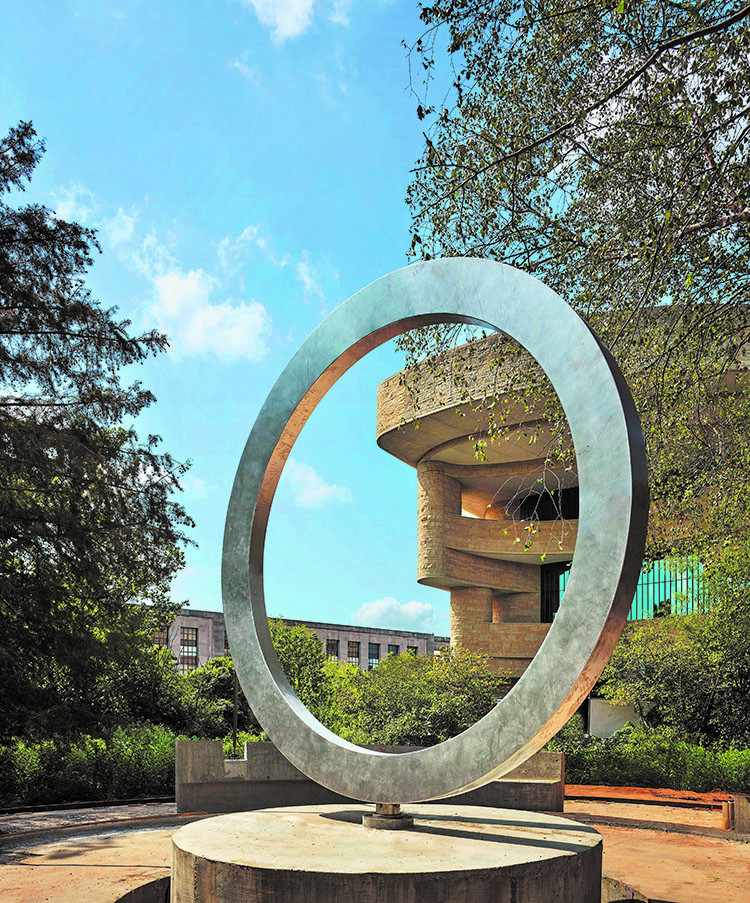
By Micheal Rios, photos courtesy of Alan Karchmer for NMAI
A permanent memorial dedicated to generations of Native American military veterans was unveiled on Veteran’s Day, November 11, in the heart of Washington D.C. It’s been over twenty-five years in the making, as Congress authorized construction of such a dedication in front of the National Museum of the American Indian back in 1994.
To celebrate the momentous occasion in the age of COVID-based restrictions and social distancing, a planned dedication ceremony and veterans procession was replaced with a virtual program. Opening the video presentation was none other than Tulalip’s own Board of Director and Army veteran, Mel Sheldon.
“I’d like to start by thanking our elders and veterans. All the brave men and women who have served before us created the foundation for our next generation,” said Mel during the initial moments of the twenty-two minute program. “They created a legacy that extends to the younger leaders of our country, as well as those who are now currently serving in the armed forces.
“My father was a Marine and he served in World War II. His example led me to carrying on that proud tradition when, at just 19-years-old, I served in Vietnam as a helicopter pilot,” he continued. “Here at Tulalip, we have a number of women who have served in the military and in our traditional way we raise our hands to them for their courage and service. There have been 29 million people serving in the U.S. military from World War I to Iraq and Afghanistan, and a good portion of them are proud Native Americans. [We] have served at a very high rate in the military and we’re very proud of that warrior tradition.”
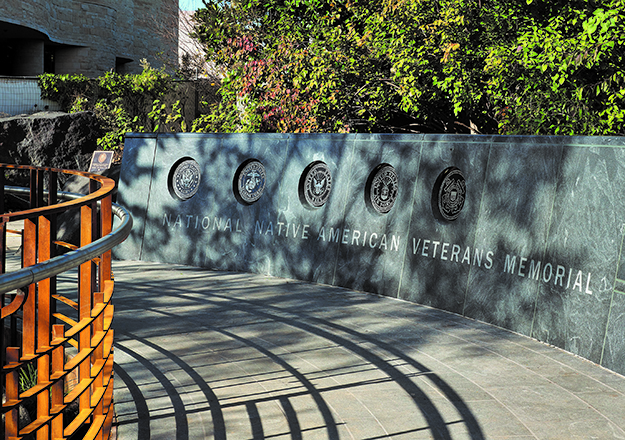
Native men and women have always been defenders of their lives, traditional homelands, and cultural lifeways. The call to serve in the United States military has been strong for our people since the nation’s founding, long before being officially recognized as U.S. citizens in 1924.
In fact, the Department of Defense recognizes that today’s military successes depend heavily on the contribution of America’s first people. Thirty-one thousand proud Native American men and women are on active duty today, serving in Iraq, Afghanistan, and elsewhere around the world. In total there are 140,000+ Native veterans living, breathing, and passing on teachings about honor and duty to a cause much larger than oneself.
The best stat of all is as a demographic, Native Americans serve in the armed forces at five times the national average and enlist in the military at the highest per-capita rate of any other group. A longstanding warrior tradition of so many, past and present, is now forever memorialized with a federal monument in the U.S. capital.
Designed by multimedia artist and Marine Corps veteran, Harvey Pratt (Cheyenne and Arapaho), the one-of-kind fixture features an elevated stainless steel circle resting on a carved stone drum. It also incorporates water for sacred ceremonies, benches for gathering, and four lances where veterans, family members, tribal leaders and others can attach prayer ties for healing.
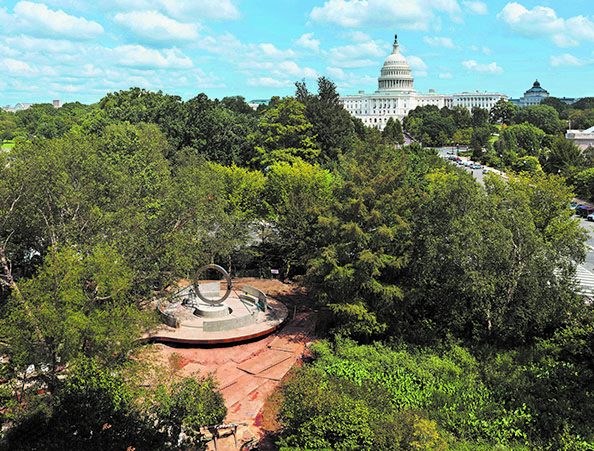
“That big vertical circle that stands in the middle, I call it the hole in the sky where the Creator lives. When you pray, that prayer goes through there and the Creator receives it and blesses you,” explained Harvey in an interview with Indian Country Today. “No matter how you feel about how our country has treated Native people, it’s important to honor all our Native warriors. They fought to protect the land we live on. That’s what warriors do.”
While the warrior mentality to protect the sacred has a long and prideful history, at the same time Native communities have never taken a loss of life lightly. Paying homage to fallen warriors as heroes with reverent memorials filled with ceremonies and prayers is a traditional teaching that unites tribal members of all 574 federally recognized tribes. Dubbed the Warriors’ Circle of Honor, this memorial intends to unite any and all visitors though a connection of service and sacrifice by Native veterans, past and present.
“The National Native American Veterans Memorial will serve as a reminder to the nation and the world of the service and sacrifice of Native American veterans,” said Kevin Gover (Pawnee), NMAI director. “Native Americans have always answered the call to serve, and this memorial is a fitting tribute to their patriotism and deep commitment to this country.”
Please use the following link to download the November 21, 2020 issue of the syəcəb
